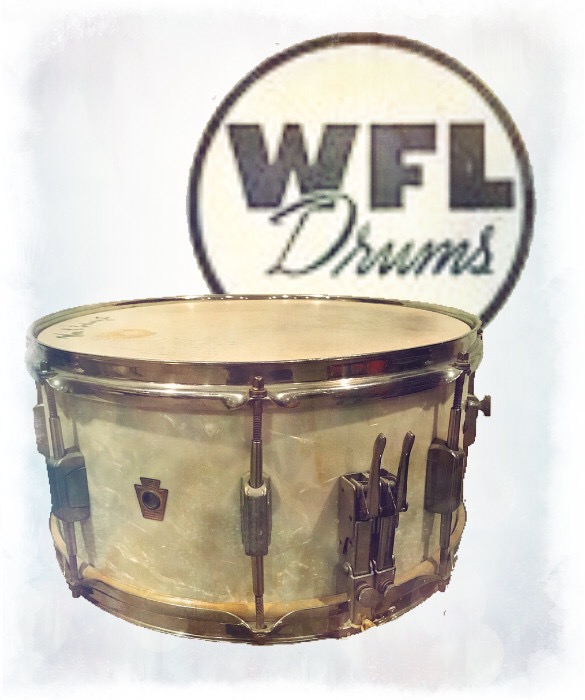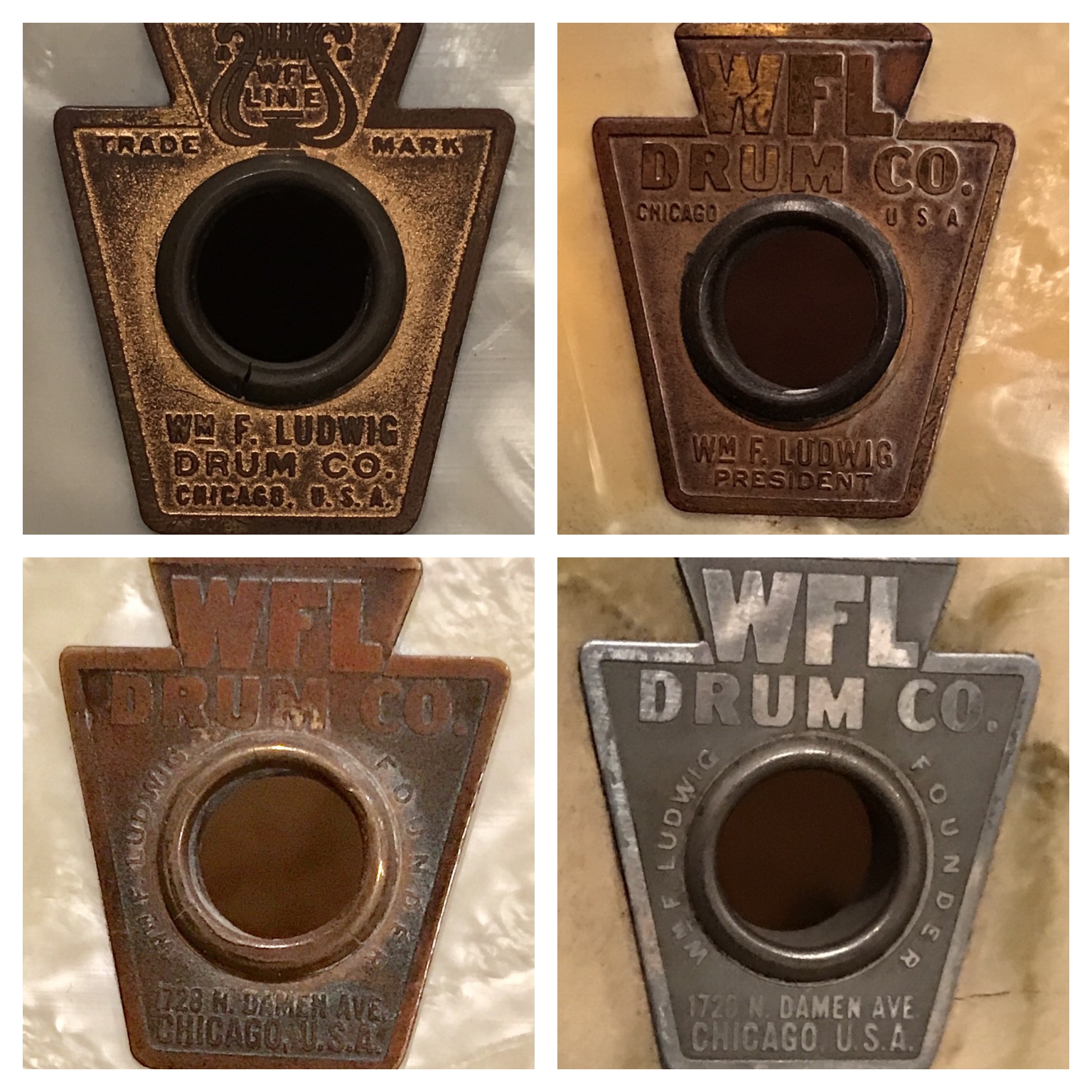In my last column article I wrote about how John Densmore and the “little” orange drum set started my curiosity about vintage Ludwig drums. Now I am one of those people that like to know the full story so as I began researching 60s Ludwigs, I kept going further back. I was reading everything I could about vintage Ludwig drums anywhere I could find it as the Internet and google were not yet around. John Aldridge was now making black and white full versions of Not So Modern Drummer and vintage drum shows were just starting to pop up. It was a 1993 issue of Modern Drummer that had just come out that got my attention as well known collector Harry Cangany was writing a featured column called the Collectors Corner. In this particular issue Harry was talking about a 1938 WFL Twin Strainer snare drum that he had just acquired and had wanted for some time. Having never seen or heard of this type of drum I was curious to learn more and hopefully find one for myself. Apparently, fate was on my side as I acquired this beauty some two weeks after reading Harry’s article and this one drum put me into a lifelong obsession with pre-war WFL drums.
The WFL Drum Company was started around 1936 as Wm. F Ludwig sold the Ludwig and Ludwig drum company he started with his brother Theobold in 1909 to Conn Selmer in 1929. William was told that things would remain the same and he could continue to run things as he had in the past but after six years, but William grew frustrated at how things were going and decided to start making his own drums the way he had originally intended. A new building was bought at 1728 N. Damen Ave in Chicago and once again the Ludwig family was in business. The earliest badges like the one on this snare drum had a Lyre design at the top and the bottom of the badge read: Wm F Ludwig Drum Co. Conn quickly pointed out that they had ownership of the Ludwig name so William changed the company name to simply WFL Drum Co. The company had two lug designs that were offered in the catalog on flagship lines and the first was a spring loaded lug called the P-90 which is what this drum has. The second design was taken from the ever popular Zephyr trains of the 1930s that everyone seemed to fall in love with and the lugs were simply called Zephyr lugs. These lugs had a sleek design and the tension rods inserted directly into the casing. Most of the drums were made in a 7x14 size though other sizes were available as this drum is actually a 6.5x14 and I have also seen them in the 5.5x14 size and even own a drum that is a whopping 7x15!
Harry wrote in his original article that the first twin strainer drums had strainers that were pointed in a more outward direction. This was changed rather soon as it was noticed that the arms had a habit of catching things thus making them susceptible to damage. The later designs featured arms that were slightly curved in enough to prevent possible damage and my drum has its original arms in the outward position with everything fully functional and unharmed as this drum spent most of its life in a case. There are many questions that I would have loved to ask WFL senior about why and when things happened but, for now, some that will just remain a mystery. For instance, WFL had tw different designs for throw-offs and the hole patterns for drilling each throw-off were in a different spot making it impossible to interchange the different style of throw-off with the other. I have seen many WFL drums with strainers on either side of the badge as well. At first I thought maybe they had versions made for right and left handed players but I have seen an equal share of drums that have strainers on either side so I’m not quite sure the reasoning behind it. I have also seen at least 5 different pre-war WFL badges and a spring loaded lug design that was not cataloged. Most of the drums I have seen have an African mahogany interior as this is what is advertised in the catalog however I have seen many drums with maple interiors and own two myself. The Twin Strainer WFL also was available in wrap finishes, painted dual color finishes, solid painted finishes, plain mahogany finishes and metal shells. The 1941 catalog also offered a painted faux marble finish called Deluxe marble finish which I have a full set with matching Twin Snare. Twin strainer snares also had several different size options, wood hoop options and were also available as marching drums.
Because WFL was an upstart company in the late 30s and they were working off a very small budget, I believe this is a partial reason for some of the many oddities that I have come across. Wm F Ludwig lived through a depression that forced him to sell his first company so, by the time WFL was started, he would save money anywhere he could which is a practice that carried right through the 60s. If this meant using up older parts or discontinued parts to fill an order, then that is what they did. Many drums are around that do not fit into a catalog description of what was offered because odd parts were used or parts were put on a drum that was no longer in production. Ray Bauduc was also WFL’s first big name endorser and it was tough to compete with Conn’s Ludwig and Ludwig and the Slingerland Radio King that had top drum stars Gene Krupa and Buddy Rich as endorsers. On that fateful day, December 7th 1941, America was thrust into war and a 10% restriction was put on all metals used in the manufacturing of non-essential products. WFL forged ahead with an all wood drum called the Victorious model and, after the war ended in 1945, WFL was able to go back to using metal parts again. Thinking the old lug designs were wearing tired Wm F Ludwig came up with the classic lug design in 1947 that Ludwig still uses today.
There are many great examples of Twin Strainer drums left in the world but the parts are extremely hard to find. WFL continued to offer many of the parts as replacements up until the early 50s but most of those drums then were considered dinosaurs compared to the current offerings. Finding the strainers is probably the toughest part as there is a right and left half of each version, chrome or nickel version, and a smaller size version for 5.5x14 drums. The second version of the throw-offs also have very fragile tips and many a drum can be found with the strainer tips broken off. Most of the drums were also outfitted with a 10 strand set of snares for one side and a set of six silk wound snares for the other side. Occasionally I have seen drums with gut snares as an option as well. Many of the twin snares I have come across are missing either one or both sets of snares and they can also be very hard to replace. Lots of things in the drumming world have changed since the late 30s/early 40s but these Twin Strainer drums bring a look, sound and a design that comes from an era of great invention. Grab one if you can because they are a very cool piece of drumming history and, oh… they sound great!




